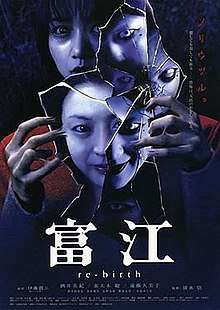Tomie: Re-birth
Tomie: Re-birth (富江 re-birth) is a 2001 Japanese horror film directed by Takashi Shimizu as the third installment of the Tomie film series, based on a manga of the same name by Junji Ito.[1][2][3][4] The film was released in Japan on March 24, 2001, and screened at the Manila Eiga Sai (Japanese Film Festival) in Philippines on September 3, 2005.[5][6]
| Tomie: Re-birth | |
|---|---|
 | |
| Directed by | Takashi Shimizu |
| Produced by |
|
| Screenplay by | Yoshinobu Fujioka |
| Based on | Tomie by Junji Ito |
| Starring | |
| Music by | Gary Ashiya |
| Cinematography | Yoichi Shiga |
| Edited by | Ryuji Miyajima |
Production company | Planet Entertainment |
| Distributed by | Starmedia Home Entertainment |
Release date |
|
Running time | 101 minutes |
| Country | Japan |
| Language | Japanese |
Plot
An artist named Hideo is painting his girlfriend Tomie (Miki Sakai), but she dismisses it as a poor painting and he kills her in a jealous rage with an art knife and his two friends Shunsuke and Takumi help him bury her. When the three friends are at a party Tomie shows up and the artist kills himself in the bathroom. Tomie latches onto Shunsuke and his mother kills Tomie and they cut her up together in an unnatural ecstasy. They then burn her head, which has already started to regenerate and has some crude limbs for locomotion. The portrait of Tomie allows for her regeneration, as her supernatural blood mixed with the pigments. Takumi's girlfriend Hitomi gets possessed by Tomie, in a rather viral fashion. In a fit of jealousy, the two Tomies try to eliminate the other.
Hitomi doesn't want to become a monster, and so they decide to commit suicide. However, when at a waterfall, about to commit suicide, Tomie's head grows on the side of Hitomi's neck next to her head. They all die and then Takumi's sister comes and throws flowers into the water. A small facial mole can be seen directly beneath the sister's left eye, suggesting that, because Takumi gave her the portrait of Tomie, she was also possessed by her. Thus, the sister is the newest Tomie.
Cast
- Miki Sakai as Tomie Kawakami
- Satoshi Tsumabuki as Takumi Aoyama
- Masaya Kikawada as Shunichi Hosoda
- Kumiko Endô as Hitomi Kitamura
- Shugo Oshinari as Hideo Kamata
- Shin Kusaka as Masaru
- Mia Murano as Rie Aoyama
- Akira Yasuda as Waiter
- Shunsuke Ito as Yutaka
- Yutaka Nakajima as Tomoko Hosoda
- Kumiko Endo as Hitomi Kitamura
- Yuri Hachisu as Yumiko Sano
- Taro Suwa as Haruo Aoyoma
- Ganko Fuyu as Takako Aoyama
- Yoshie Otsuka as Sachiko Kimata
- Masako Itou as Norika
- Hiroaki Muchima as Himself
- Emi Itou as Sawori
Reception
Blogcritics made note of the film's slow pace, quiet sets, and lack of gore, and wrote that there even with its high body count, there appeared to be "a conscious effort to keep to decorum in the traditional sense of the word, which means to say even during a dismemberment there is still little to show for it except an artfully expanding pool of blood and Tomie’s severed head watching from a bowl."[4] In admitting he lacked the cultural references, The reviewer felt that a viewer would "probably need to be a fan of the manga and the previous movies to get anything from this."[4] He wrote he appreciated the slow pace of a creeping horror film having the ability to give him "the heebie-jeebies",[4] but that the pacing in this film seemed pointless, the representation of a "pixie-cute girl with the tittering laugh"[4] was annoying, and he did not understand the interactions between the players.[4]
The horror reviewing website 10,000 Bullets made note of the various Tomie films using different actresses for the character of Tomie, but that only the villain's name was consistent in each of them. They appreciated that director Shimizu was able to inject his personal style "without ever losing sight of the character's roots."[7] They noted that while Re-Birth is "more disgusting than scary", the cast performances are the best in the series so far, making special note of Miki Sakai's performance as Tomie and how her "unnerving laugh and haunting her eyes tell so much more than any dialog could."[7] The noted that some of the imagery from Replay was brought over into Re-Birth, and that the film "starts off strong before metamorphosing into something that is so strange it almost parodies itself".[7]
Release
Tomie: Re-birth was released in Japan on March 24, 2001.[8]
The film was released on DVD in an anamorphic widescreen format by Ventura in May 2004. DVD extras include trailers for films in the Tomie series, as well as interviews with the director and cast.
References
- Cooper, Tracie AllRovi. "Tomie: Re-birth (2001)". Rotten Tomatoes. Retrieved June 9, 2012.
- "Tomie: Rebirth (2001)". The New York Times. Retrieved June 10, 2012.
- Wallis, J. Doyle (May 17, 2004). "DVD review: Tomie: Rebirth". DVD Talk. Retrieved June 9, 2012.
- "Movie Review: Tomie: Re-Birth - The Living Dead Girl". February 28, 2010. Blogcritics. Retrieved June 9, 2012.
- Ledesma, Bea (August 19, 2005). "The Japanese horror picture show". Philippine Star. Retrieved June 10, 2012.
- Joanna Barck, Petra Löffler (2005). Gesichter des Films (in German). Transcript. pp. 149–158. ISBN 3899424166.
- Boer, Michael Den. "DVD review: Tomie Rebirth". September 25, 2004. 10,000 Bullets. Retrieved June 11, 2012.
- Kalat 2007, p. 284.
References
- Choi, Jinhee; Wada-Marciano, Mitsuyo (2009). Horror to the Extreme: Changing Boundaries in Asian Cinema. Hong Kong University Press. ISBN 9622099734.CS1 maint: ref=harv (link)
- Kalat, David (2007). J-Horror: The Definitive Guide to The Ring, The Grudge and Beyond. Vertical Inc. ISBN 978-1-932234-08-4.CS1 maint: ref=harv (link)